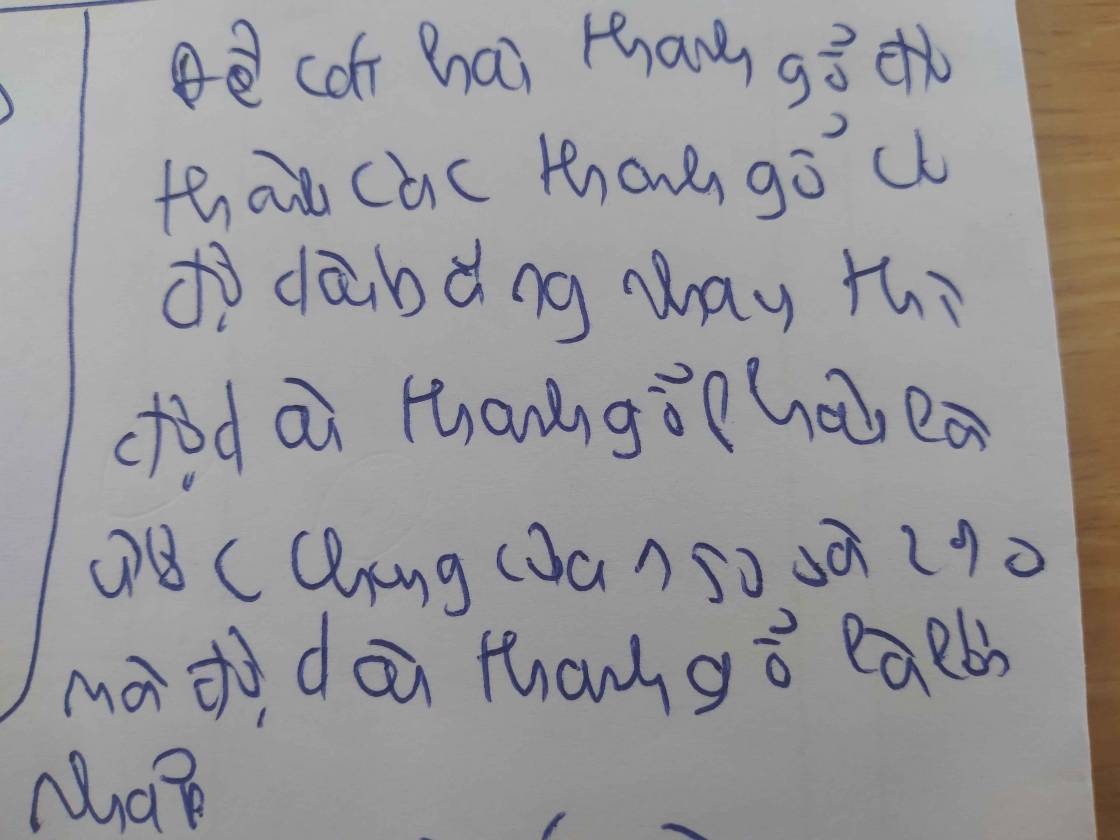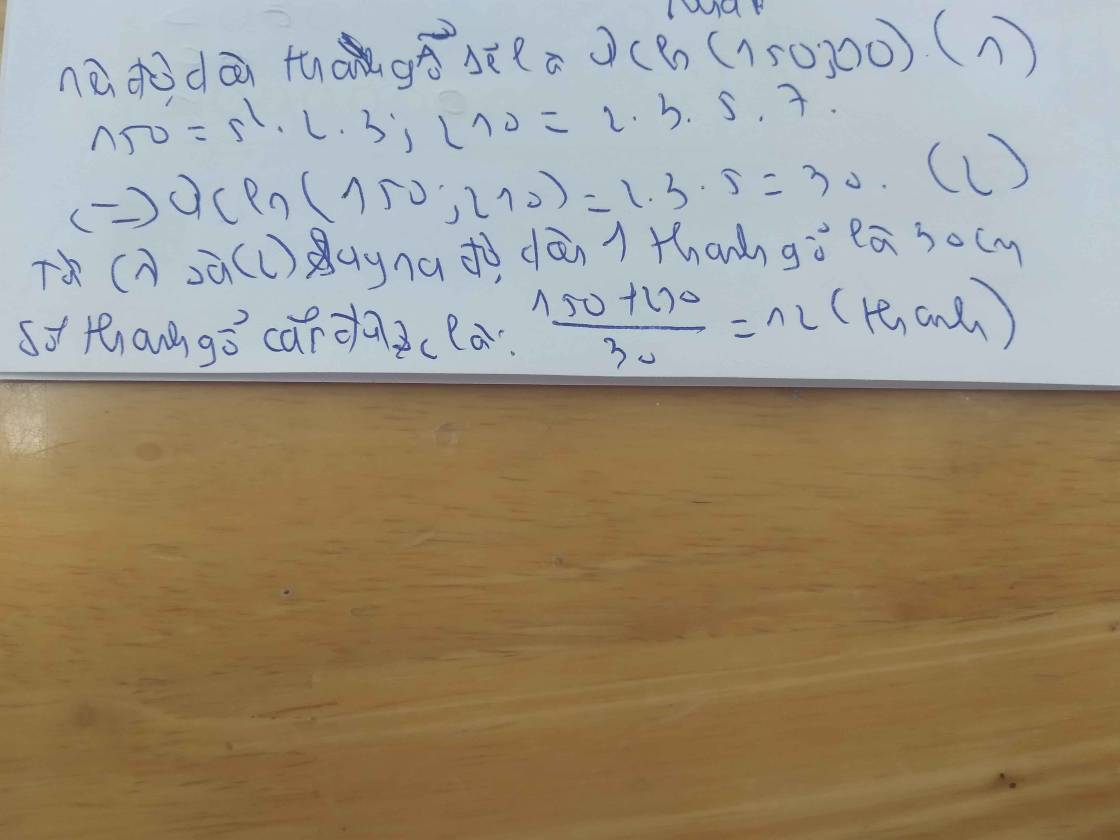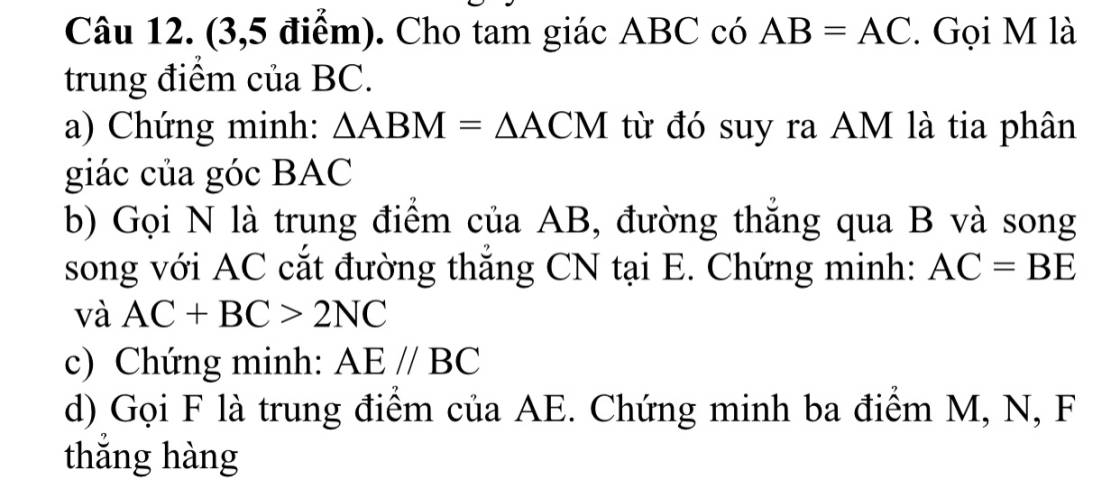Giúp mình với bạn mình cần gấp ngay trong tối nay anh hơi mờ nhìn cố nha tạ ơn ạ

Hãy nhập câu hỏi của bạn vào đây, nếu là tài khoản VIP, bạn sẽ được ưu tiên trả lời.

12:
a: Xét ΔABM và ΔACM có
AB=AC
BM=CM
AM chung
=>ΔABM=ΔACM
=>góc BAM=góc CAM
=>AM là phân giác của góc BAC
b: Xét ΔNAC và ΔNBE có
góc NAC=góc NBE
NA=NB
góc ANC=góc BNE
=>ΔNAC=ΔNBE
=>AC=BE
c: Xét tứ giác AEBC có
AC//BE
AC=BE
=>AEBC là hình bình hành
=>AE//BC
d: Xét ΔEAC có EF/EA=EN/EC
nên FN//AC//EB
Xét ΔECB có CM/CB=CN/CE
nên NM//EB
=>F,N,M thẳng hàng

1)sao phân biệt được v của ai A hay B sửa vA và vB
a)thời gian của hai xe gặp nhau
t=sAB/vA+vB=2/9h=800s
b)sau 0,5h thì người đi từ A đi được
sA=vA.tA=30km
sau 0,5h thì người đi từ B đi được
sB=vB.tB=15km
khoảng cách của hai xe lúc này
s1=(sA+sB)-sAB=25km
c)sau 1h thì người đi từ A đi được
sA1=vA.tA1=60km
sau 1h thì người đi từ B đi được
sB1=vB.tB1=30km
khoảng cách của hai xe lúc này
s2=(sA+sB)-sAB=70km
d)tổng quãng đường đi được ;20-10=10km
sA+sB=10
vA.tA2+vB.tB2=10
60.t+30.t=10
90t=10
t=1/9h
câu 2,3 giống cách làm nhưng đáp án khác dựa vào đó làm dễ mà

The Tay, with local groups Pa dí, Thổ, Ngan, Phén, Thu Lao, is an ethnic group of 54 ethnic groups in Viet Nam. Tay people speak Tay, a Tai dialect of the Tai-Kadai language. Tay people live mainly in lowland areas of northern Vietnam. The Tay was previously known as the Tho (although this name is now used to refer to a different ethnic group, see Turks). Tay people have the second largest population in Vietnam. Tay people, Nung have a close relationship with the Choang people in China.Tay people mainly reside in the northern midland and mountainous provinces (1,400,519 people in 1999). In addition, in the recent time, the Tay also migrated to some provinces in the Central Highlands like Dak Lak and Lam Dong.The Tay are usually at the foot of the mountain or along the stream. The name is often referred to by the name of hills, fields, rivers. Each village has 15 to 20 houses. Large villages divided into many small villages.Tay dressed in indigo. Traditional Tay costumes are made from self-made cotton yarn, dyed indigo on men's and women's clothes, almost without decorative pattern. Tay clothing can be considered one of the simplest outfits of 54 ethnic groups. The costume is simple but meaningful.Then singing, singing, singing sli are used in various activities, popular folk songs of the Tay. Musical instruments such as the Micro, Shake. Chess is an instrument that is present in all spiritual activities of the Tay, such as soul in the folk dance of the Tay. In this life, the sex acts as a means of communicating bold identity.Traditional houses are usually on stilts, lands and roofs with grass and some border areas have defense types. In the house to distinguish male rooms outside, women in the chamber. Most popular are 3-room, 2-roofed houses (no chop), logs of land or bushes, surrounding woods, roofs of grass, picturesque Tay people settle in groups of about 15 to 20 households. Tay people worship ancestors and animals. The Tay ancestors' altar is placed in the middle of the house and made into a private space and revered. Pregnant women and their newborns are not allowed to sit or lie on chairs or beds in front of the altar. In the Tay religion, the most important feast day of the Tay people is usually the last day of the lunar month.The life of the Tay is often associated with nature, so the food and foodstuff of the Tay people are products obtained from production activities in areas with forests, rivers, streams and hills surrounding. Some famous dishes are: sticky egg rolls, sticky rice balls, sour bamboo shoots, stigma.
The Tay, with local groups Pa dí, Thổ, Ngan, Phén, Thu Lao, is an ethnic group of 54 ethnic groups in Viet Nam. Tay people speak Tay, a Tai dialect of the Tai-Kadai language. Tay people live mainly in lowland areas of northern Vietnam. The Tay was previously known as the Tho (although this name is now used to refer to a different ethnic group, see Turks). Tay people have the second largest population in Vietnam. Tay people, Nung have a close relationship with the Choang people in China.Tay people mainly reside in the northern midland and mountainous provinces (1,400,519 people in 1999). In addition, in the recent time, the Tay also migrated to some provinces in the Central Highlands like Dak Lak and Lam Dong.The Tay are usually at the foot of the mountain or along the stream. The name is often referred to by the name of hills, fields, rivers. Each village has 15 to 20 houses. Large villages divided into many small villages.Tay dressed in indigo. Traditional Tay costumes are made from self-made cotton yarn, dyed indigo on men's and women's clothes, almost without decorative pattern. Tay clothing can be considered one of the simplest outfits of 54 ethnic groups. The costume is simple but meaningful.Then singing, singing, singing sli are used in various activities, popular folk songs of the Tay. Musical instruments such as the Micro, Shake. Chess is an instrument that is present in all spiritual activities of the Tay, such as soul in the folk dance of the Tay. In this life, the sex acts as a means of communicating bold identity.Traditional houses are usually on stilts, lands and roofs with grass and some border areas have defense types. In the house to distinguish male rooms outside, women in the chamber. Most popular are 3-room, 2-roofed houses (no chop), logs of land or bushes, surrounding woods, roofs of grass, picturesque Tay people settle in groups of about 15 to 20 households. Tay people worship ancestors and animals. The Tay ancestors' altar is placed in the middle of the house and made into a private space and revered. Pregnant women and their newborns are not allowed to sit or lie on chairs or beds in front of the altar. In the Tay religion, the most important feast day of the Tay people is usually the last day of the lunar month.The life of the Tay is often associated with nature, so the food and foodstuff of the Tay people are products obtained from production activities in areas with forests, rivers, streams and hills surrounding. Some famous dishes are: sticky egg rolls, sticky rice balls, sour bamboo shoots, stigma.
THAM KHẢO



 các bạn giúp mình câu 5 nhé mình cần gấp lắm ạ!!! chỉ trong tối nay thui ạ !!! cảm ơn
các bạn giúp mình câu 5 nhé mình cần gấp lắm ạ!!! chỉ trong tối nay thui ạ !!! cảm ơn 
 * Mọi người cố giúp em hoàn thiện trong buổi tối nay với ạ, em đg cần gấp! Cảm ơn ạ!
* Mọi người cố giúp em hoàn thiện trong buổi tối nay với ạ, em đg cần gấp! Cảm ơn ạ!
 giúp mình gấp! nhanh nha bạn, mình cần ngay bây giờ, các bạn làm dc bao nhiêu thì làm ạ, em cảm ơn rất nhiều!
giúp mình gấp! nhanh nha bạn, mình cần ngay bây giờ, các bạn làm dc bao nhiêu thì làm ạ, em cảm ơn rất nhiều!

Bài 1:
a) Áp dụng tích chất dãy tỉ số bằng nhau:
\(\dfrac{x}{2}=\dfrac{y}{3}\)=\(\dfrac{x+y}{2+3}\)=\(\dfrac{-15}{5}\)= -3
=> x= -3.2= -6; y= -3.3= -9.
b) Áp dụng tích chất dãy tỉ số bằng nhau:
\(\dfrac{x}{3}=\dfrac{y}{4}\)=\(\dfrac{x-y}{3-4}\)=\(\dfrac{12}{-1}\)= -12
=> x= -12.3= -36; y= -12.4= -48
c) 3x=7y=\(\dfrac{x}{7}=\dfrac{y}{3}\)
Áp dụng tích chất dãy tỉ số bằng nhau:
\(\dfrac{x}{y}=\dfrac{y}{3}=\dfrac{x-y}{7-3}=\dfrac{-16}{4}=-4\)
=> x= -4.7= -28; y= -4.3= -12
d) \(\dfrac{x}{y}=\dfrac{17}{13}=\dfrac{x}{17}=\dfrac{y}{13}\)
Áp dụng tích chất dãy tỉ số bằng nhau:
\(\dfrac{x}{17}=\dfrac{y}{13}=\dfrac{x+y}{17+13}=\dfrac{-60}{30}=-2\)
=> x= -2.17= -34; y= -2.13= -26
e) Áp dụng tính chất dãy tỉ số bằng nhau:
\(\dfrac{x^2}{9}=\dfrac{y^2}{16}=\dfrac{x^2+y^2}{9+16}=\dfrac{100}{25}=4\)
=>x= 9= \(3^2\)= 3.4= 12; y= 16= \(4^2\)= 4.4= 16
Bài 2:
2x=3y=\(\dfrac{x}{3}=\dfrac{y}{2}\); 5y=7z=\(\dfrac{y}{7}=\dfrac{z}{5}\)
-> \(\dfrac{x}{3}=\dfrac{y}{2};\dfrac{y}{7}=\dfrac{z}{5}\) = \(\dfrac{x}{21}=\dfrac{y}{14};\dfrac{y}{14}=\dfrac{z}{10}\)=> \(\dfrac{x}{21}=\dfrac{y}{14}=\dfrac{z}{10}\) = \(\dfrac{3x}{63}=\dfrac{7y}{98}=\dfrac{5z}{50}\)
Áp dụng tích chất dãy tỉ số bằng nhau:
\(\dfrac{3x}{63}=\dfrac{7y}{98}=\dfrac{5z}{50}\)=\(\dfrac{3x-7y+5z}{63-98+50}\)=\(\dfrac{30}{15}=2\)
=> x= 2.21= 42
=> y= 2.14= 28
=> z= 2.10= 20